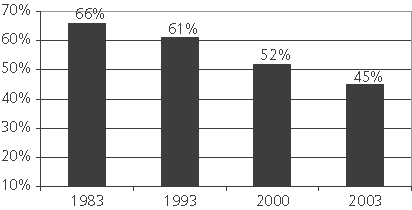Wage Stagnation vs. Living Wages for U.S. Workers Today
Far from earning living wages, most U.S. workers have experienced wage stagnation since the 1970s--a trend largely obscured by political rhetoric and misinformation.
Job-based health insurance is terminally ill. A long-term decline in the percentage of workers who get health insurance through their jobs and a sharp rise in monthly costs are giving workers a bad case of "un-surance." They now bear more of the costs of medical care and are less certain than ever that their health benefits will be there in the future.
[seealso id="1"]
The pain has been acute since the recent economic downturn. A report from the Kaiser Family Foundation shows that employee contributions for health premiums increased a remarkable 50% between 2000 to 2003 (see Figure 1). In those three years, the percentage of private-sector workers who received insurance through their employers fell from 52% to 45%, according to the U.S. Labor Department (see Figure 2). Today, 80% of the nation's 44 million uninsured are in working families.
The current crisis is part of a long-term erosion in employee health benefits that dates back to the late 1970s. From 1983 to 2003, workers' monthly contributions for family health benefits, adjusted for inflation, almost quadrupled (see Figure 3). As costs shot up, the portion of private-sector workers covered through their jobs dwindled from two-thirds in 1983 to fewer than half in 2003.
Why the steep drop in job-based coverage? One reason is that the labor market has changed. Workers today are less likely to be in a union and more likely to work part time. In addition, more people work in the service sector, where employers often provide less generous health benefits than in manufacturing.
| 2000 | 2003 | % Increase | |
| Employee Portion of Annual Premium | |||
| Single Coverage | $334 | $508 | 52% |
| Family Coverage | $1,619 | $2,412 | 49% |
| PPO Deductibles | |||
| Preferred Provider | $175 | $275 | 57% |
| Non-Preferred Provider | $340 | $561 | 65% |
| Prescription Drug Co-Payments | |||
| Preferred Drugs | $13 | $19 | 46% |
| Non-Preferred Drugs | $17 | $29 | 71% |
| *Includes public- and private-sector employees. Source: Kaiser Family Foundation, Employer Health Benefits Survey, 2003. Note: Preferred Provider Organization (PPO) is a popular form of health plan. A PPO controls costs by contracting with "preferred" doctors. Patients receive the highest financial benefit if they see a preferred doctor. Patients are allowed to go "out-of-network," but bear more of the costs themselves if they do so. |
Figure 2Percent of Private-Sector Workers Receiving Job-Based Health Insurance

Source: Bureau of Labor Statistics, 2000, 2002, 2003
The other reason is that health insurance costs have exploded. Between 1980 and 2003, health care spending as a percent of gross domestic product increased from 9% to over 15%. Much of the cost inflation is driven by technological improvements and the increased use of health services. Another driver is the political influence of the powerful health care industry. Big Pharma's sway on Capitol Hill was recently demonstrated by the passage of the Medicare drug bill in 2003, sections of which were virtually written by large pharmaceutical companies.Figure 3Average Monthly Employee Contribution for Health Insurance Premiums, in 2003 dollars*

*Includes only private-sector employeesSource: Bureau of Labor Statistics, 2001, 2002, 2003.
Current trends in job-based health benefits suggest that the future may be even bleaker for working people. Deductibles and co-payments, the fees individuals pay when they actually visit the doctor or purchase prescriptions, are the main source of growth in employee health care spending, aside from rising monthly premiums (see Figure 4).
Increasing these point-of-service costs is more than just another employer cost-shifting strategy.
Ratcheting up co-pays and deductibles is also a way for companies to limit the medical services that employees use. The higher the front-end costs to workers, the fewer total services used, and the lower the amount companies pay out for insurance. In effect, employers are using point-of-service fees to control overall costs.
| 1999 | 2003 | |
| Union | 73% | 60% |
| Nonunion | 51% | 44% |
| Goods Producing | 69% | 57% |
| Service Producing | 48% | 42% |
| Full-time | 64% | 56% |
| Part-time | 14% | 9% |
| Source: BLS Employee Benefits Survey, 1999, 2000, 2003 |
Virtually all health care policy experts agree that some form of rationing is an inevitable part of any health care system. In countries with government-provided health insurance, the state allots care based on criteria like medical need and service availability. Similarly, managed care systems ration medical services according to rules that control costs—for example, by limiting access to specialists.
Pro-market policymakers and the insurance lobby decry the evils of government rationing, but in reality, U.S. employers already do ration care. Unlike a government health insurance system in which decisions about access to care are made based on fairness-related criteria, Americans' access to medical care is rationed by their ability to pay. The result? Seniors skip drug doses to make their prescriptions last longer and employees with high co-payments avoid going to the doctor because they have to pay the rent.
Most people in the United States don't think of medical care as a consumer good, but as a necessity to which everybody should have equal access. As prices rise and coverage shrinks, it might become something else altogether—a luxury item.